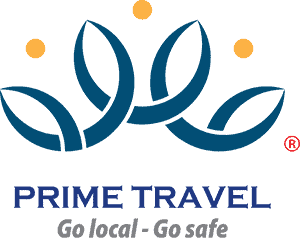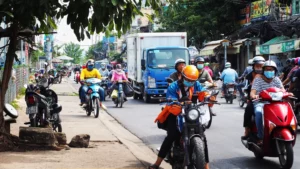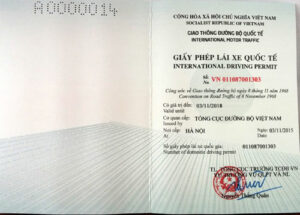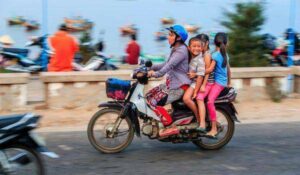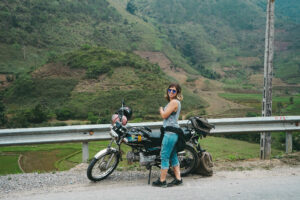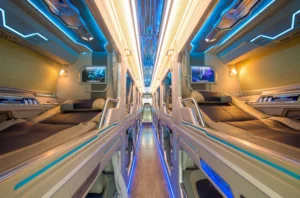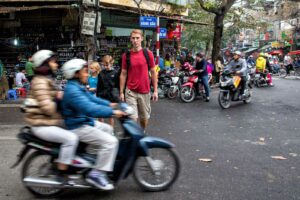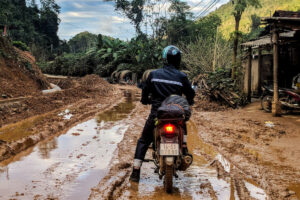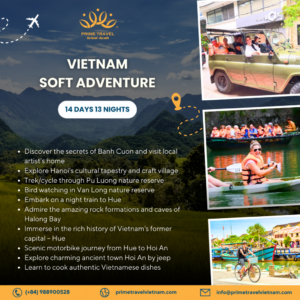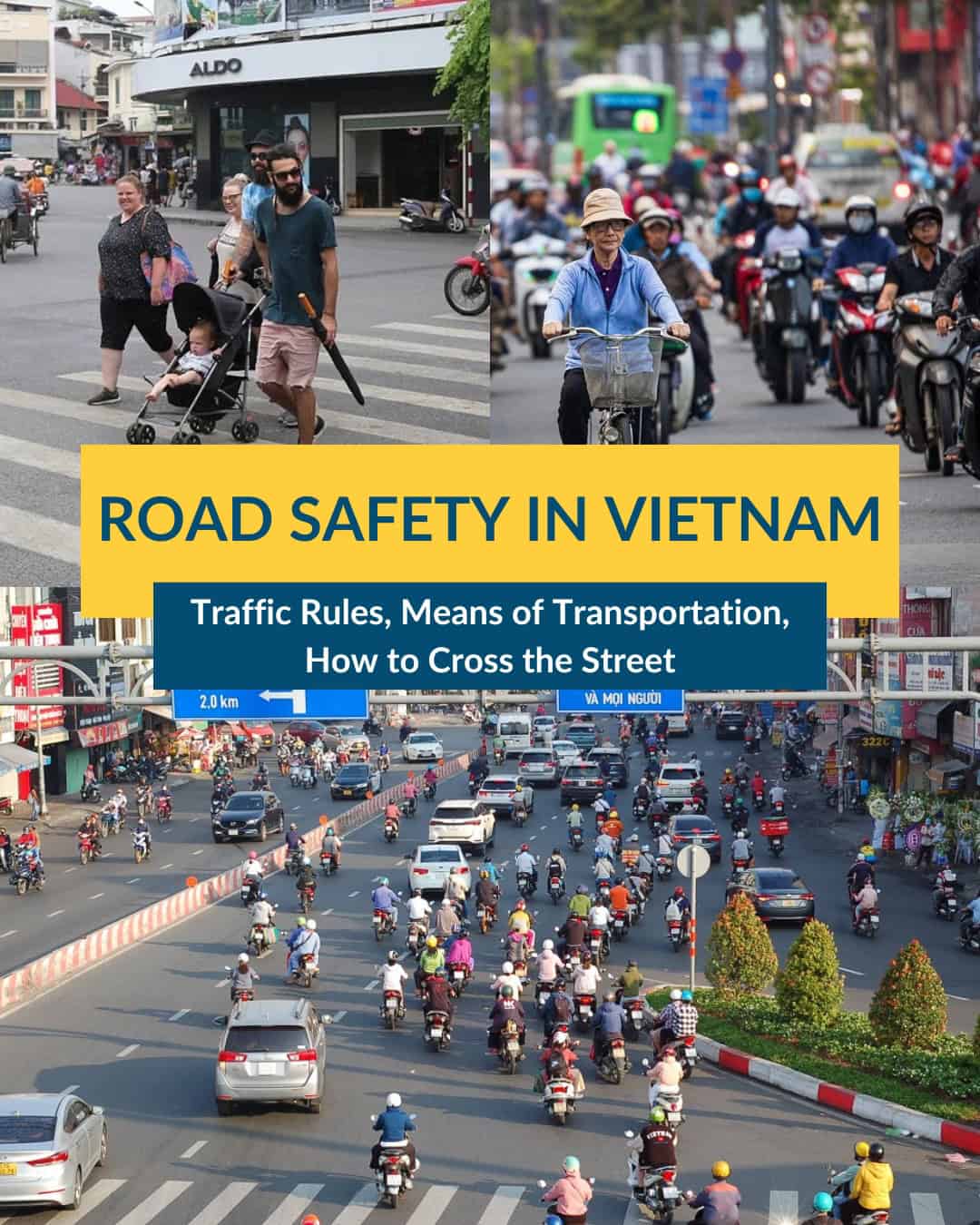
Road Safety and Traffic in Vietnam: A COMPLETE Guide for First-Timers
Vietnam is an exciting destination, filled with natural beauty, rich history, and unique things to explore. However, when it comes to traffic in Vietnam, it is often described as “crazy” or “chaotic”. For many first-timers, navigating through the traffic here can feel overwhelming.
To fully enjoy your journey to Vietnam, it’s crucial to be aware of road safety. In this guide, Prime Travel will walk you through the road safety and traffic in Vietnam. Whether you’re walking, riding a motorbike, or traveling by car, these tips will keep your journey safe and stress-free.
Important traffic rules in Vietnam
Yes, of course, traffic rules in Vietnam still exist even when you witness a lot of photos and videos showing the chaotic scenery of traffic here. Therefore, to ensure a safe trip in the busy traffic in Vietnam, it’s crucial to understand the country’s traffic rules. Not only will these help you stay safe, but they’ll also keep you out of trouble with local authorities.
Speed limits
Speed limits vary depending on the vehicle and location. In general, you should not go over 40 km/h in cities and 60 km/h in urban areas. On highways, limits can range from 60 to 100 km/h. Keep an eye out for road signs; speed limits are enforced, especially near traffic cameras and intersections. Last but not least, remember to slow down whenever you go nearby schools, hospitals, and residential areas.
Avoid using your cellphone while driving
Using your phone while driving or riding is prohibited unless you have a hands-free device. Distractions in Vietnam’s dense traffic can lead to serious accidents, so it’s best to stay focused on the road at all times.
Helmet use
It’s mandatory for both drivers and passengers to wear helmets when riding motorbikes. Make sure your helmet meets local safety standards, not just for legality, but for your own protection.
Zero alcohol limit
Vietnam enforces a strict zero-tolerance policy for alcohol when driving. Even one drink can result in hefty fines (starting from $75 to $110 USD for motorbikes) or license suspension. If you plan to drink, take a taxi or ride-hailing service for your own safety and other people.
Drive on the right side of the road
Vehicles in Vietnam drive on the right. If you come from a country that drives on the left, this may take some getting used to, especially at intersections or roundabouts.
Required driving license
To drive legally, you must have a valid Vietnamese license or an International Driving Permit (IDP) accepted in Vietnam. Police occasionally conduct license checks, especially in tourist-heavy areas like Hanoi, Ho Chi Minh City, Da Nang, Ha Giang, etc.
Illustration photo
Motorbike classification
Motorbikes are classified based on engine size. If you plan to rent a motorbike, note that bikes above 50cc require a valid license. Also, motorcycles under 50cc are rarely available for rent and are not suitable for riding in hilly or mountainous areas.
Passenger limit on a motorbike:
Legally, only one passenger is allowed on a motorbike, making it a total of two people per bike. You may see locals carrying more, but this is against the law.
However, you can carry more than one passenger when you carry a sick person for emergency medical treatment, escorting someone who has committed a legal violation, or carrying children under the age of 14.
Read more>>>Vietnam Travel Scam Alert 2025: Top 15 Common Scams And How To Avoid
Popular means of transportation for tourists in Vietnam
Vietnam offers a wide variety of transportation options, making it easy for tourists to explore the country based on comfort, budget, and adventure level. Whether you’re heading to the mountains or the coast, there’s always a convenient way to get around.
Motorbike
Motorbikes offer freedom to explore off-the-beaten-track places in Vietnam, helping you travel like a local. It’s also incredibly flexible and easy to navigate through crowded places and narrow streets. For adventurous travelers, renting a motorbike is a fascinating way to explore Vietnam’s cities and countryside.
Motorbike rentals are available almost everywhere, from big cities to rural and mountainous areas, with prices ranging from 150,000 to 250,000 VND (around $6 to $10 USD) per day. You may be asked to leave a passport or a small deposit.
However, if you’re planning to go on a long journey like the Ha Giang Loop, it’s best to get an easy rider who is familiar with the tricky mountain roads.
Taxis and Ride-Hailing Apps
Taxis are easy to find in major cities like Hanoi, Ho Chi Minh City, and Da Nang. Stick with reputable companies like G7, Mai Linh, Vinasun, or XanhSM to avoid scams. The fee is about 15,000–20,000 VND (under $1 USD) per kilometer.
For a more reliable fare, use ride-hailing apps like Grab, Gojek, or Be, which offer upfront pricing and various vehicle types, including cars and motorbike taxis. These services are especially helpful in urban areas and airports.
Private Car with Driver
We don’t recommend renting a car and driving yourself if you’re not a seasoned traveler in Vietnam. Unfamiliar rules, vehicle specifications, and traffic signs in Vietnam can be a big problem for foreign travelers here.
Hiring a private car with a driver is the safest and most comfortable way to travel, especially for families or groups. It’s ideal for day trips to places like Ninh Binh. Prices vary depending on the route, but typically start at 2,000,000-3,000,000 VND/day. Booking through a trusted travel company ensures professional drivers and well-maintained vehicles.
Sleeper Buses
Sleeper buses are a cost-effective way to cover long distances. They’re common on routes like Hanoi to Sapa or Ho Chi Minh City to Da Lat. A one-way ticket ranges from 250,000 to 500,000 VND. Buses usually depart at night, saving you a night’s stay, but keep in mind that road conditions and driving styles can be rough for sensitive travelers.
Trains
Vietnam’s rail system is reliable for long routes, particularly Hanoi to Hue, Da Nang, or Ho Chi Minh City. The trains are slower than buses or flights, but offer scenic views and more space to relax. Ticket prices vary depending on your destination and the seat class.
For example, a train ticket from Hanoi to Da Nang ranges from 600,000 VND ($23 USD) for soft seats to 900,000 VND ($34 USD) or more for soft sleepers. Trains are safer and more comfortable than buses, especially for families and older travelers.
Domestic Flights
For fast and affordable travel, domestic airlines like Vietnam Airlines, Bamboo Airways, and Vietjet Air connect all major cities and tourist areas. Flying is the safest and most time-efficient choice for longer distances.
Read more>>>What Not To Do In Vietnam For Tourists in 2025 – New Vietnam Laws
How to cross the street in Vietnam
Crossing the street in Vietnam can be a fun, challenging, and cultural experience for every traveler. Due to the bustling traffic and limited availability of safe crossings, some tourists might find it difficult to navigate through the heavy traffic and motorbikes, which seem to rarely stop.
Although it seems like chaos, there is an unspoken understanding between drivers and pedestrians in Vietnam. With a few simple tips, you’ll quickly get the hang of it, and crossing the street might even become one of your favorite cultural experiences.
Walk at a steady pace (DON’T RUN)
One of the most important tips is to walk at a calm, steady pace without rushing or stopping abruptly. Sudden movements confuse motorbike drivers, who often rely on predicting your direction to swerve around you. It may feel scary at first, but keeping a consistent pace allows traffic to flow around you safely.
Use traffic lights and designated crossings
Traffic lights might not be everywhere in the countryside. But in big cities, whenever possible, cross the road at the designated crossings or traffic lights. Make sure to wait for the pedestrian signal to allow you to cross the road. Even when the signal is on, remember to look both ways and stay alert since somebody might run a red light and cause a traffic accident.
Make yourself visible to drivers
Avoid crossing in dark or hidden spots like behind buses or parked cars. If it’s nighttime, carry something reflective or use your phone’s flashlight. Raising your hand slightly while crossing is a common local gesture that signals your presence to drivers, helping them adjust their speed accordingly.
Follow the locals
If you’re nervous, wait for a group of locals and cross alongside them. Locals are experienced in navigating the flow of traffic; they know when to move. Many tourists feel safer moving in a group rather than alone.
Wait for large vehicles to pass by
Always let large vehicles like buses, trucks, and cars pass before you step onto the road. These vehicles are harder to stop and less agile than motorbikes. Once they pass, motorbikes are easier to predict and maneuver around.
Tips to be safe in traffic and on the road in Vietnam
Staying safe on Vietnam’s busy roads starts with knowing the basics. Whether you’re a passenger or a driver, small precautions can make a big difference.
Adhere to traffic rules
Always follow traffic rules, including speed limits and right-of-way laws. Obeying signals and signs may not be common practice among locals, but it keeps you protected.
Always riding with a valid license
If you’re riding a motorbike, make sure you have a valid license and an International Driving Permit (IDP). Riding without one can lead to fines or even void your insurance. It’s also crucial to wear a helmet, stay alert, and avoid distractions like texting or using headphones.
Choose trusted transportation providers
If you decide to book transportation, always stick to reputable providers. You can look up their names online and read reviews to check their reputation. Use trusted ride-hailing apps like Grab, Gojek, Be, or official taxi companies to avoid scams.
Be careful when traveling with a sleeper bus at night
When traveling by sleeper bus, you should always opt for well-known transportation companies, especially when you spend the night on the bus. Otherwise, consider alternative transportation options or opt for daytime travel. It tends to be safer and more reliable.
Be mindful of road conditions for road safety
Potholes, loose gravel, or sudden obstacles are common, especially in rural areas. If you’re traveling during the rainy season, be cautious of slippery roads or landslides in mountainous areas. Daytime travel is usually safer and provides better visibility.
Consider getting travel insurance
No matter how cautious you are, unexpected situations can still arise while traveling. Having travel insurance gives you peace of mind and financial protection in case something goes wrong.
Always wear a seatbelt, even if locals don’t
In Vietnam, it’s quite common to see passengers skipping the seatbelt, especially in taxis or backseats. But safety should always come first. Wearing a seatbelt can greatly reduce the risk of serious injury in the event of an accident, no matter how short the ride.
Read more>>>Travel to Vietnam from Philippines: Best Tours and Travel Information 2025
FAQ
When is rush hour in Vietnam?
Rush hour typically occurs from 7:00 AM to 9:00 AM and 4:30 PM to 6:30 PM in major cities like Hanoi and Ho Chi Minh City. The traffic during this time can leave you stuck for hours. We suggest you stay indoors if you don’t need to go outside during these hours.
Is it safe to ride a motorbike in Vietnam?
Riding a motorbike can be fun and flexible, but traffic is chaotic and accidents are common. Only experienced riders with proper licenses should attempt it.
Can I use my driver’s license in Vietnam?
No, most foreign licenses are not valid in Vietnam. You’ll need an International Driving Permit (IDP) with a motorbike endorsement, plus your home license.
Are the traffic signs in English?
Most signs use international symbols, but written instructions are in Vietnamese. Be sure to learn basic symbols or travel with a guide.
Is it safe to take local buses?
Local buses are affordable, but routes and schedules can be confusing, and drivers may drive aggressively. For convenience, consider tourist shuttles or ride-hailing apps.
What should I do in case of a traffic accident?
Vietnam’s National Traffic Safety Committee suggests calling the police by dialing 113 in case of any accidents. You can also call 115 for medical emergencies. If anybody is injured, seek help immediately from the locals and try to identify nearby hospitals.
Highly recommend Vietnam tours in Summer
- 14-Day Cultural and Culinary Journey Through Vietnam
- 14-Day Vietnam Soft Adventure
- 10-Day Mekong Delta Cultural Experience from Vietnam to Cambodia
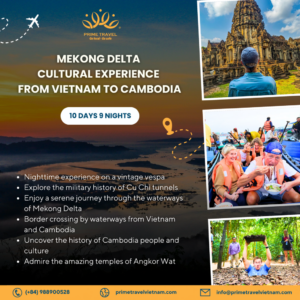
Essential Da Nang Guide and Itinerary: Best Things to Do for Travelers 2025
Visit Vietnam In July – Weather, Traditional Festival and Best Places To Visit 2025
Vietnam Tours From Australia: Best Tours And Holiday Packages 2025
